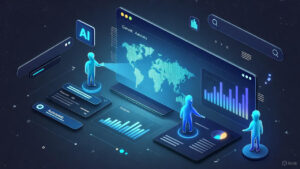The Reality of AI Integration in Modern Workplaces
Artificial intelligence has moved beyond proof-of-concept demonstrations into production environments across multiple sectors. What we’re observing in our deployments isn’t a distant future scenario but a present-day shift in how work gets accomplished. The systems we’ve built over the past three years reveal patterns that business leaders need to understand now, not later.
The transformation manifests in unexpected ways. In our implementations, AI handles document processing at speeds that would require teams of analysts, yet the technology remains largely invisible to end users. This operational invisibility is deliberate. The measure of successful AI deployment isn’t whether people notice the technology but whether outcomes improve.
Current production systems demonstrate a significant economic shift. Analysis of our deployments shows AI-powered workflows delivering equivalent output at approximately 10% of traditional operational costs. This isn’t theoretical projection but measured performance across multiple client implementations. The cost-performance ratio continues to improve as models become more capable and infrastructure costs decline.
Which Functions Face the Greatest Disruption
After three years of building AI systems in production, certain patterns emerge about which roles experience the most significant transformation. The distinction isn’t simply about repetitive versus creative work. It’s more nuanced than that.
Functions Under Immediate Pressure
Data processing and analysis roles face substantial automation. Our systems routinely handle tasks that previously required skilled analysts: extracting structured information from documents, identifying patterns in datasets, generating initial reports. The speed differential is stark. What took a team days now completes in minutes.
Customer service operations are being restructured around AI capabilities. We’ve deployed systems that handle tier-one support inquiries with resolution rates comparable to human agents. The economic pressure here is intense because the cost difference is substantial and the technology works reliably for well-defined scenarios.
Financial services operations involving transaction processing, compliance checking, and preliminary analysis are increasingly automated. Our implementations in adjacent sectors show that tasks requiring pattern recognition and rule application are particularly susceptible to AI displacement.
Where Human Advantage Persists
Complex negotiation and relationship management remain human domains. AI can support these functions with data and analysis, but the nuanced reading of situations and building of trust still requires human judgement. We haven’t seen production deployments that successfully automate stakeholder management.
Strategic decision-making in uncertain environments continues to benefit from human cognition. AI excels at optimising within defined parameters but struggles with the kind of contextual reasoning that senior leadership requires. The technology augments these roles rather than replacing them.
Adaptation Strategies That Work in Practice
Our experience deploying AI systems reveals what actually helps organisations and individuals transition effectively. The successful approaches differ significantly from typical change management advice.
Organisational-Level Responses
Companies that approach AI implementation as a capability upgrade rather than a cost-cutting exercise achieve better outcomes. The difference is material: systems designed to enhance human capabilities get adopted and deliver value, whilst those positioned as replacement technology face resistance and deliver limited returns.
Investment in technical infrastructure matters more than most organisations anticipate. The companies that can integrate AI effectively have robust data systems and APIs in place. Poor data quality and fragmented systems create bottlenecks that no amount of sophisticated AI can overcome.
Individual-Level Adaptation
The professionals who thrive alongside AI systems develop what we might call “orchestration skills”. They understand enough about AI capabilities to know what to delegate to automated systems and what requires human attention. This isn’t the same as learning to code, though technical literacy helps. It’s more about developing judgement around where AI adds value and where it introduces risk.
Continuous learning becomes operationally necessary rather than aspirationally desirable. The pace of AI capability improvement means that what worked six months ago may no longer be optimal. The individuals and teams that build in regular capability assessment and adjustment outperform those that don’t.
- Focus on problems rather than tools: The professionals who adapt most effectively concentrate on understanding business challenges deeply and then evaluate whether AI can help address them, rather than starting with the technology and looking for applications.
- Build feedback loops: Creating mechanisms to measure whether AI-augmented processes actually improve outcomes helps identify where the technology adds value and where it creates problems that aren’t immediately obvious.
The Economics Are Driving Faster Change Than Expected
The cost-performance curve of AI systems is improving faster than most projections anticipated. This has implications that business leaders need to factor into planning.
In sectors where we’ve deployed systems for over 18 months, we’re observing operational cost reductions of 70-90% for specific functions. These aren’t theoretical projections but actual measured results from production deployments. The implications are considerable: companies that achieve these efficiencies can price aggressively whilst maintaining margins, creating competitive pressure across entire sectors.
The speed of capability improvement means that functions which appeared immune to automation 24 months ago are now candidates for AI augmentation. Our testing of models released in 2024 shows performance on complex reasoning tasks that would have seemed implausible in 2022. Extrapolating this trajectory suggests additional functions will become automatable sooner than current workforce planning assumes.
Capital Markets Are Responding
Investment patterns reveal market recognition of these dynamics. Companies demonstrating effective AI integration are receiving valuation premiums whilst those perceived as vulnerable to disruption face increasing discount. This creates a feedback loop: well-capitalised companies can invest more aggressively in AI capabilities, increasing their competitive advantage.
The pressure on traditional business models is intensifying. In sectors where AI can deliver comparable results at a fraction of the cost, the economics force adaptation regardless of preferences about technology adoption. Companies can’t ignore these cost differentials indefinitely without losing competitive position.
What the Timeline Actually Looks Like
Based on our deployment experience and the trajectory of model capabilities, we can sketch some reasonable expectations about the pace of change.
Near-Term Horizon: 12 to 24 Months
Expect continued rapid deployment of AI in administrative and analytical functions. The technology is ready, the economics are compelling, and organisations have learned enough about implementation to scale deployments. The primary constraint is organisational adaptation speed rather than technical capability.
Professional services firms face particular pressure. Functions that primarily involve information processing and analysis are increasingly automated. The firms that successfully reposition around higher-value advisory work will maintain margins; those that don’t will face intense pricing pressure.
Medium-Term Considerations: 2 to 5 Years
As AI systems become more capable at complex reasoning and multi-step tasks, additional professional functions become candidates for augmentation or automation. Our testing of frontier models suggests capabilities in planning, strategy development, and nuanced analysis are improving rapidly.
The combination of AI with robotics and physical automation will accelerate transformation in manufacturing, logistics, and service delivery. The economic pressure becomes more intense as the cost-performance advantages compound.
The integration of AI into workplace operations is neither the catastrophic disruption some fear nor the seamless transition others promise. It’s a substantial economic and operational shift that requires intelligent response from both organisations and individuals. The companies and professionals who understand the genuine capabilities and limitations of current systems, and adapt their operations accordingly, will capture significant advantage. Those who dismiss or delay engagement with these technologies will find themselves at an increasing disadvantage as the cost-performance differential widens.
What matters now is practical implementation and measured results, not speculation about future possibilities. The systems we’re deploying today are already changing how work gets done. The question isn’t whether to engage with AI but how to do so effectively.
Let's Explore What's Possible
Whether you're tackling a complex AI challenge or exploring new opportunities, we're here to help turn interesting problems into innovative solutions.


